According to our 2023 Marketing Strategy Trends Report, 42% of marketers leverage social media, and it has the highest ROI of any channel. With this in mind, sharing content on social media is a no-brainer.

Whether you’re looking for a strategy refresh or leveraging the channel for the first time, this post is your guide to the different types of social media content and the benefits it’ll bring to your business.
Different Types of Social Media Content
1. Video (short form, specifically)
Short-form video is the top trend marketers will be leveraging in 2023, and HubSpot’s 2023 Social Media Trends Report found that it is the highest ROI format for social media marketing.
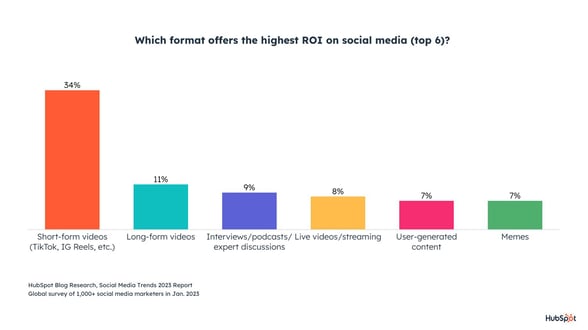 With this in mind, creating short-form videos is a worthwhile investment, and some common examples are TikTok videos, Instagram Reels, and YouTube shorts. The TikTok below is a video from Topicals, a skincare company, which talks about the different uses for one of its products.
With this in mind, creating short-form videos is a worthwhile investment, and some common examples are TikTok videos, Instagram Reels, and YouTube shorts. The TikTok below is a video from Topicals, a skincare company, which talks about the different uses for one of its products.
Long-form video is also popular, but it doesn’t come close to the ROI of short-form. Live video gained steam during the pandemic, allowing people to participate in events remotely. Twitch is a popular live-streaming platform where people can interact with their favorite creators in real time.
2. Audio chat and live rooms.
Audio chat is another type of social media content, and many platforms have native features like Twitter Spaces, LinkedIn Live, or Facebook Live Audio. It’s also the top content type marketers plan to leverage for the first time in 2023.
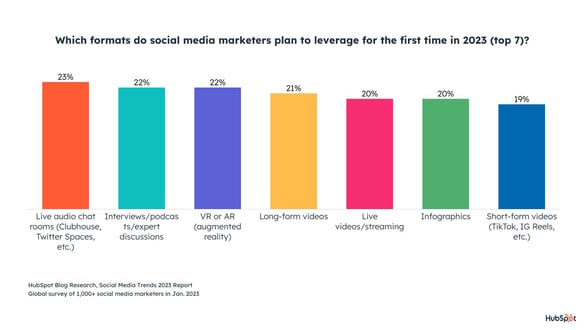 This makes sense, as audio chat rooms let brands directly communicate with audiences and develop closer relationships than seeing a billboard or watching a YouTube video. And, during a time when customers value connections with brands more than ever, audio chat rooms are a valuable tool.
This makes sense, as audio chat rooms let brands directly communicate with audiences and develop closer relationships than seeing a billboard or watching a YouTube video. And, during a time when customers value connections with brands more than ever, audio chat rooms are a valuable tool.
Audio chat rooms are trendy among Gen Z. A Spotify study found that 80% of Gen Z enjoy audio content because it allows them to express their individuality and explore different sides of their personalities.
3. Content that represents brand values.
Content that represents brand values is anything that shares what your company stands for in addition to and outside of the products you sell, such as commitments to sustainable production practices, treatment of employees, or any causes you support.
Consumers care more than ever about what the brands they buy from stand for and the values they have. They want to know the causes that businesses support and the commitments made to bettering the world.
The image below is a Tweet from Ben & Jerry’s that expressed its commitment to environmentalism and combating climate change, which aligns with its stated core values of environmental protection.
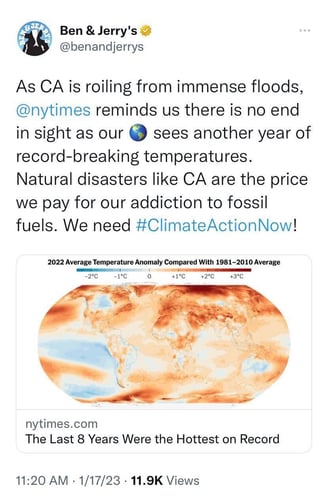
Brand value content helps you draw in people whose values align with yours, and marketers also say that it has the 5th biggest ROI of any trend. 44% of marketers are also already posting this type of social media content.
4. User-generated content.
User-generated content (UGC) is content your audience creates that features your business/brand that is not paid for by your business. For example, someone shares a non-sponsored TikTok about how much they like your product or posts a picture wearing your clothing and tags your business.
This type of content is great to share on social media because it helps your audiences see that people use and like your products, vouching for you in a real-life way.
UGC pays off, as customers trust reviews from friends and family more than they trust branded ads, and 79% of people say UGC highly impacts their purchase decisions, considerably more so than branded content and influencer content.
When you do use UGC, the platforms it performs best on are Instagram, Facebook, and YouTube.
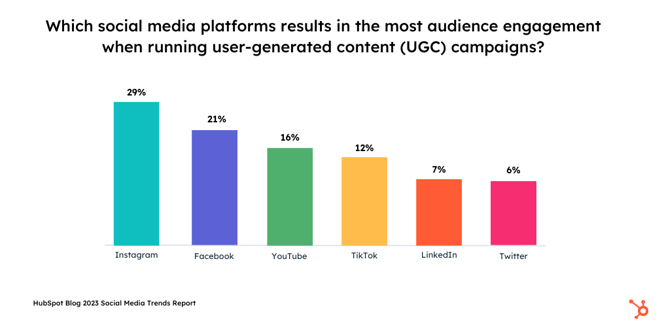
5. Funny, trendy, and relatable content.
Funny, trendy, and relatable content on social media can be hopping on viral memes, relating them to your business, and using trending hashtags or sounds. This type of content requires awareness of what’s happening on social media, cultural moments, and current events and creating buzzy content related to that.
36% of marketers already share funny, trendy, and relatable content on social media, and 66% say that funny content is the most effective, followed by relatable, trendy content. Consumers say that funny content is the most memorable.
6. Shoppable content.
Shoppable social media content allows consumers to browse through products on your accounts, discover things they like, and even make a purchase without leaving the app. The image below is an Instagram storefront for Ink Meets Paper, where someone can browse its products, find what interests them, and make a purchase.
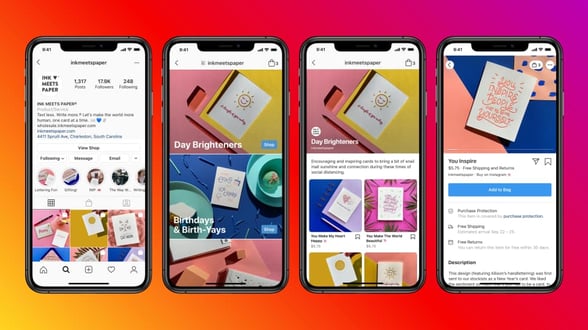
This is a valuable content type as social shopping is currently on the rise, and consumers are discovering new products and buying products on social media apps more than ever before.
In fact, social media is the most popular way for Gen Z, Millennials, and Gen X to discover new products, and over 1 in 5 have made an in-app purchase in the past three months. If you share shoppable content, the most effective platforms for selling in-app are Instagram and Facebook.
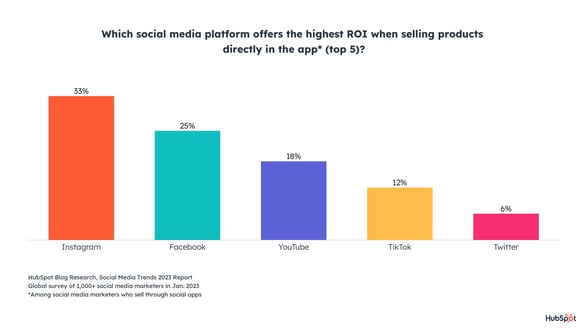
7. Educational content.
Educational content shares helpful information with audiences that helps them reach their goals and meet their needs. Educational content can come in infographics, videos, text-based posts, images — any of the content types we discussed in this post.
HubSpot often shares educational content through YouTube videos, where viewers can learn more about concepts of interest. The video below is a recent video that educates viewers on creating a brand style guide.
8. High-quality images
Images are a must on social media platforms, capturing attention and drawing people in. Images can be things like high-quality product photos or even a trending meme that relates to your business.
Our recent Marketing Strategy Report found that 47% of marketers leverage images as a media format and work well on all social media platforms.
9. Text-based content
We see text-based content on social media every day, like Tweets or thought-leadership posts on LinkedIn. The primary goal of text-based content is to share insight through text rather than an image or video. For example, you can pair a Tweet with an eye-catching image, but the point of the post is in the text.
Blogs are popular text-based content where people read longer posts and discover helpful information. Some popular types of blog posts are:
- How-to posts that introduce a problem, offer a solution, and discuss steps to reach a desired result.
- Lists posts that focus on a particular topic, offer several points, and provide a brief conclusion.
- What-posts that provide further information on a specific topic, with many articles surrounding comparisons of one thing to another.
- Why-posts that typically provide readers with a reason or purpose and provide details that support a focused conclusion.
10. Infographics
Infographics are a content type with the shareability and visual appeal of photos but are filled with helpful data and information. It’s an impactful form of social media content and educational content.
The image below is a post from HubSpot’s Instagram account that is an infographic that informs viewers about the most effective traits of a sales leader.
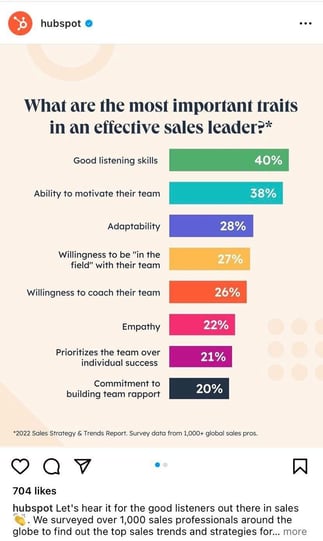
Infographics are effective, too, with 56% of marketers that regularly use them saying it’s their most effective content type.
11. Ephemeral/disappearing content.
Ephemeral/disappearing content is content that only stays up for a certain amount of time, like Instagram Stories that disappear after 24 hours. Users only have a set period to engage with it, so they might be more eager to keep track of your profiles and keep returning to experience what you share.
Creating quizzes and polls in your Stories is a great way to leverage this type of content. People only have a certain amount of time to respond, generating excitement and immediate action and inspiring respondents to come back and see results.
Repurposing Content Is Still A Valuable Strategy
Social media marketers say they use an average of four platforms, each with its best practices and norms to follow. It can be challenging to create individual pieces of content for every single platform, so many marketers share similar content on each platform but repurpose it to fit the tone and requirements of each one.
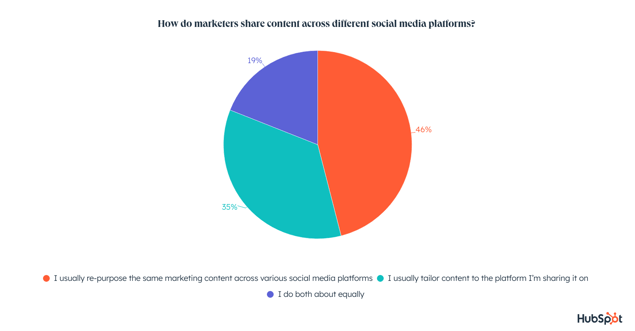 The key to success, however, is repurposing content, not resharing. People don’t look fondly at brands that share the exact same thing on each platform. 48% of marketers already share similar content across platforms with tweaks to make it more relevant to the platform’s demands.
The key to success, however, is repurposing content, not resharing. People don’t look fondly at brands that share the exact same thing on each platform. 48% of marketers already share similar content across platforms with tweaks to make it more relevant to the platform’s demands.
Want More Social Media Insights?
Learn more about the State of Social media with more of this data, videos, and exclusive industry tips on our State of Social Media Hub— which will come with a free downloadable resource.




